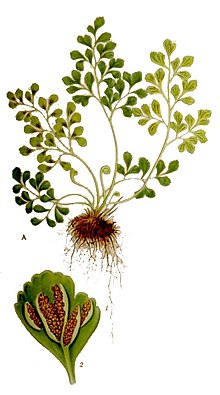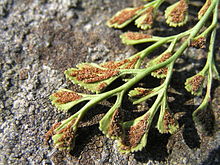Diamond wall
| Diamond wall | ||||||||||||
|---|---|---|---|---|---|---|---|---|---|---|---|---|

Wall rue ( Asplenium ruta-muraria ) |
||||||||||||
| Systematics | ||||||||||||
|
||||||||||||
| Scientific name | ||||||||||||
| Asplenium ruta-muraria | ||||||||||||
| L. |
The wall rue or the wall-striped fern ( Asplenium ruta-muraria ) is a plant from the family of the striped fern family , which often grows as a culture successor in the cracks and mortar joints of old walls.
features
They are small evergreen ferns with 3–10 (–15) cm long leaves. The leaves are two to three pinnate and irregularly triangular to oval in outline. The pinnacles that give it its name are diamond-shaped, narrowed in a wedge shape at the base and notched or incised at the front and about 2 to 3 mm long. The leaf stalks are green, as is the top of the leaf blade. When the Sori are ripe, they cover the entire underside of the feathers, which is then brown.
Spore ripening is from July to October.
The number of chromosomes is 2n = 72 or 144.
ecology
The rue is an evergreen rosette plant that can withstand drought for some time. The glands on the leaf stalk and the thickened rhizome are considered drought adaptations .
As with other ferns, fertilization is mediated by a drop of water on the underside of the prothallium. The spermatozoids are chemically attracted by the egg cells. The pre-germs are about the size of a lentil and grow in damp niches. After fertilization, the sporophytes develop. These serve both for photosynthesis and for reproduction. Spore formation takes place here almost all year round. The sporangia are arranged in long strips on the underside of the fronds, along the vascular bundles, and they are covered by a translucent indusium . The sporangia are self-dispersing with a cohesive mechanism. The spores are spread by the wind as a granular flyer.
distribution

The wall diamond is common in all temperate areas of the northern hemisphere. Originally it grew in cracks in the rock in the mountains and low mountain ranges. It tolerates both calcareous and acidic rocks. However, she prefers calcareous and nutrient-rich locations.
Because of these location preferences, the rhombus is also very often found in wall joints , even in city centers. While it only occurs in its natural habitat as a companion to other crevice plants, outside of the low mountain range it is the character species of its own plant community ( Asplenietum trichomano-rutae-murariae ; wall -diamond corridor). In the Allgäu Alps, it rises between Schüsser and Oberstdorfer Hammerspitze in Bavaria up to 2160 m above sea level.
In Austria this species is widespread from collin to subalpine and is very common in all federal states.
In Schleswig-Holstein , however, the rhombus is very rare, for example at Flensburg train station . It's on the red list there .
Systematics
One can distinguish the following subspecies:
- Asplenium ruta-muraria L. subsp. ruta-muraria : The number of chromosomes is 2n = 144.
- Dolomite wall strip fern ( Asplenium ruta-muraria subsp. Dolomiticum Lovis & Reichst .; Syn .: Asplenium dolomiticum (Lovis & Reichst.) Á. Löve & D. Löve , Asplenium eberlei D.E. Mey. ): It comes in France, Italy , Austria, Slovenia, Albania and Bulgaria. According to the Flora of China, the subspecies is also found in southwest Asia, Afghanistan, Mongolia, eastern Siberia and China at altitudes between 1500 and 3300 meters above sea level. The number of chromosomes is 2n = 72.
Importance as a fodder plant (selection)
The caterpillars of the following butterfly species depend on the plant as a food source:
- Light-banded stone spanner ( Gnophos pullata )
Common names
In Lower Austria this species is popularly known as "Stoanneidkraut". It was supposed to help with its magical powers against "verneiden" (bewitching) and was fed to the cattle. According to the German dictionary by Jacob and Wilhelm Grimm, the wall diamond is also called "donkey fern".
In the German-speaking world, the following other common names are or were used for this plant species, sometimes only regionally: Capelleken, Capelliche, Chappachläre ( Appenzell ), Chappilläre (Appenzell), Erdbrauen, Erdhar, Eselfarlin, Weiss Frauenhaar, Frauenlockkraut, Harngras ( Tyrol) near Lienz ), hard body, Juncvrowenhaar, virgin hair, wall diamonds, Meichelkraut, Murrutten, Steenruet, Steinrute, Stenvarn ( Middle Low German ), Venushaar, Wedertam ( Old High German ), Weinkräutl ( Pongau , Pinzgau ), Widder high German ( Middle German ), Widder high German, Widschertate and Widertot (Middle High German).
literature
- Oskar Sebald, Siegmund Seybold, Georg Philippi (Hrsg.): The fern and flowering plants of Baden-Württemberg . 2nd, supplemented edition. tape 1 : General Part, Special Part (Pteridophyta, Spermatophyta): Lycopodiaceae to Plumbaginaceae . Eugen Ulmer, Stuttgart (Hohenheim) 1993, ISBN 3-8001-3322-9 .
- Ruprecht Düll , Herfried Kutzelnigg : Pocket dictionary of plants in Germany and neighboring countries. The most common Central European species in portrait. 7th, corrected and enlarged edition. Quelle & Meyer, Wiebelsheim 2011, ISBN 978-3-494-01424-1 .
Individual evidence
- ↑ Pliny the Elder : C. Plinii Secundi Naturalis historia. Ed. By D. Detlefsen , I – VI (in 3 volumes), Berlin 1866–1882, here: Volume 4, p. 145: Plinius XXVII, 34 (“Asplenon [...] nascitur in petris parietibusque opacis, umidis, laudatissime in Creta “).
- ↑ a b c Tropicos. [1]
- ↑ Erhard Dörr, Wolfgang Lippert : Flora of the Allgäu and its surroundings. Volume 1, IHW, Eching 2001, ISBN 3-930167-50-6 , p. 86.
- ↑ Flensburger Tageblatt : The new enemy of the station stairs from September 11, 2013; accessed on March 1, 2014
- ↑ a b Christenhusz, M. & Raab-Straube, E. von (2013): Lycopodiophytina. - In: Euro + Med Plantbase - the information resource for Euro-Mediterranean plant diversity. Datasheet Asplenium ruta-muraria In: Euro + Med Plantbase - the information resource for Euro-Mediterranean plant diversity.
- ↑ Youxing Lin, Ronald Viane: Aspleniaceae. : Asplenium Linnaeus , pp. 267–287 - the same text online as the printed work , In: Wu Zheng-yi, Peter H. Raven, Deyuan Hong (ed.): Flora of China. Volume 2-3: Lycopodiaceae through Polypodiaceae. Science Press and Missouri Botanical Garden Press, Beijing and St. Louis, 2013, ISBN 978-1-935641-11-7 .
- ↑ Heiko Bellmann : The new Kosmos butterfly guide. Butterflies, caterpillars and forage plants. 2nd Edition. Franckh-Kosmos, Stuttgart 2009, ISBN 978-3-440-11965-5 .
- ^ Georg August Pritzel , Carl Jessen : The German folk names of plants. New contribution to the German linguistic treasure. Philipp Cohen, Hannover 1882, p. 49, online.
Web links
- Diamond wall. In: FloraWeb.de.
- Diamond wall . In: BiolFlor, the database of biological-ecological characteristics of the flora of Germany.
- Profile and distribution map for Bavaria . In: Botanical Information Hub of Bavaria .
- Asplenium ruta-muraria L. In: Info Flora , the national data and information center for Swiss flora .
- Distribution in the northern hemisphere from: Eric Hultén, Magnus Fries: Atlas of North European vascular plants. 1986, ISBN 3-87429-263-0 at Den virtuella floran. (swed.)
- Thomas Meyer: Stripe fern data sheet with identification key and photos at Flora-de: Flora von Deutschland (old name of the website: Flowers in Swabia )


